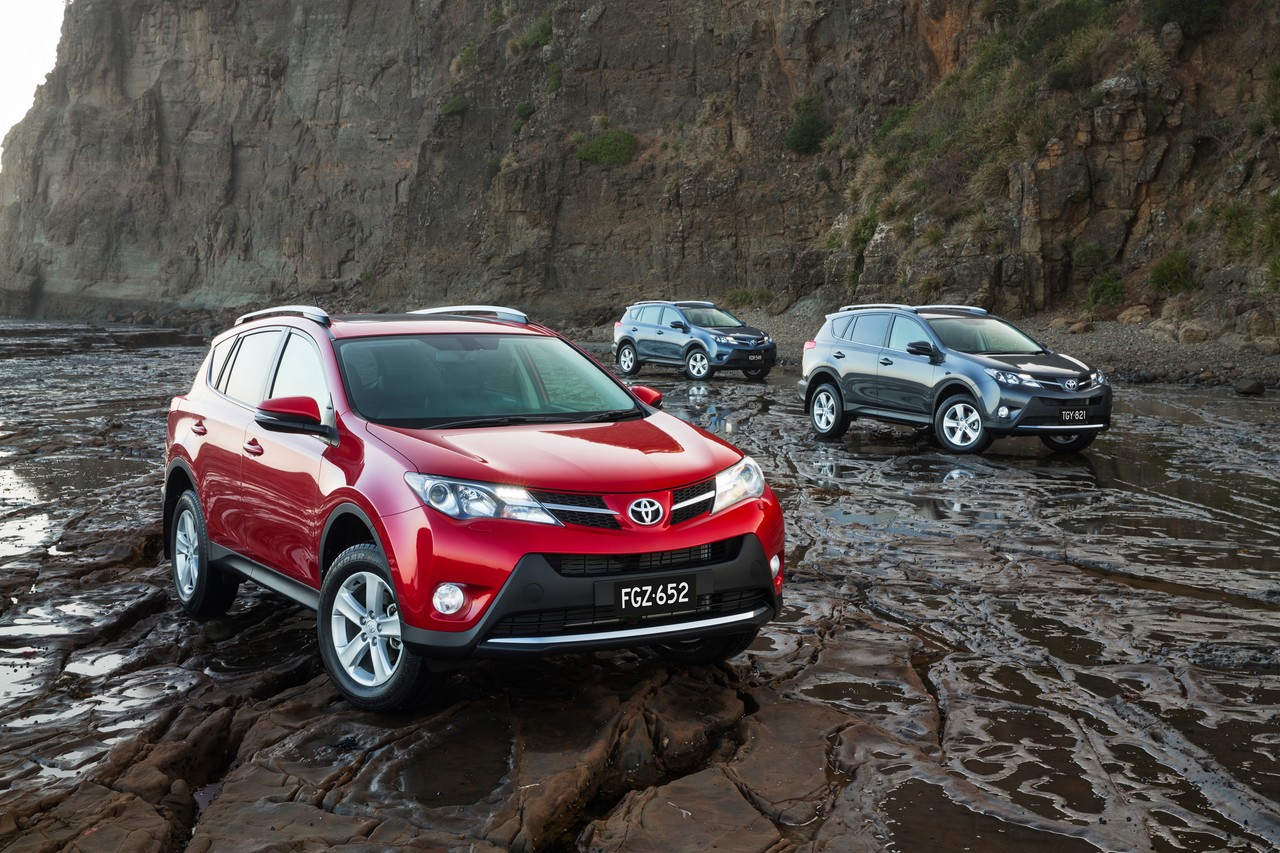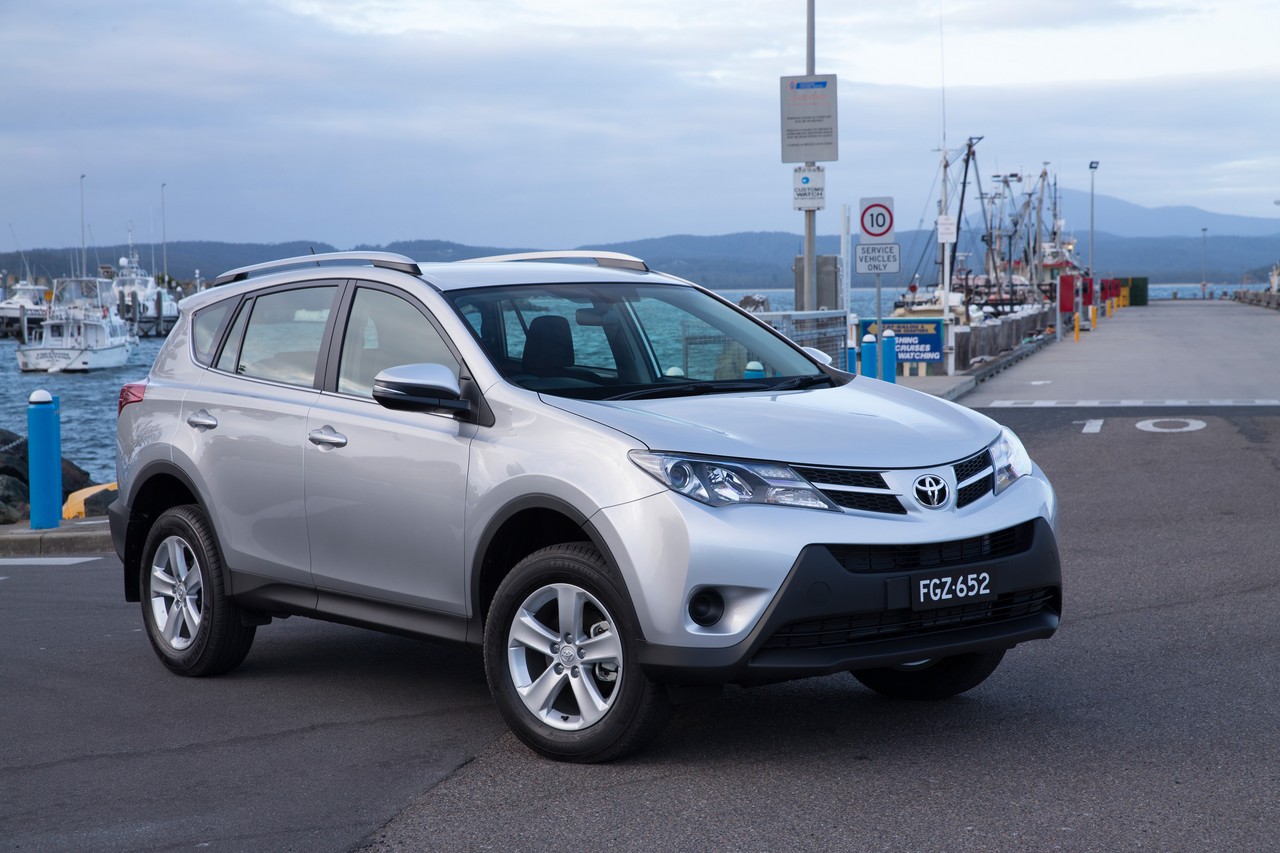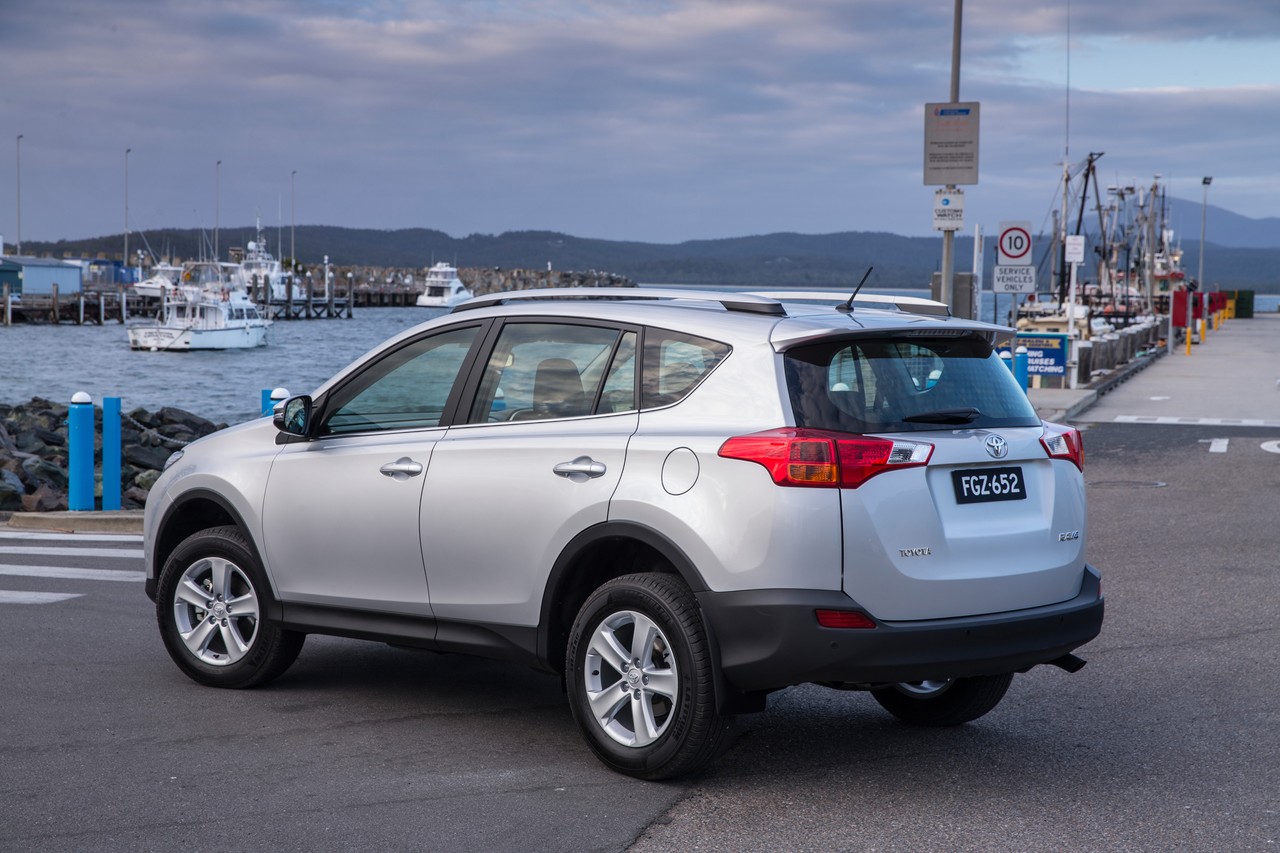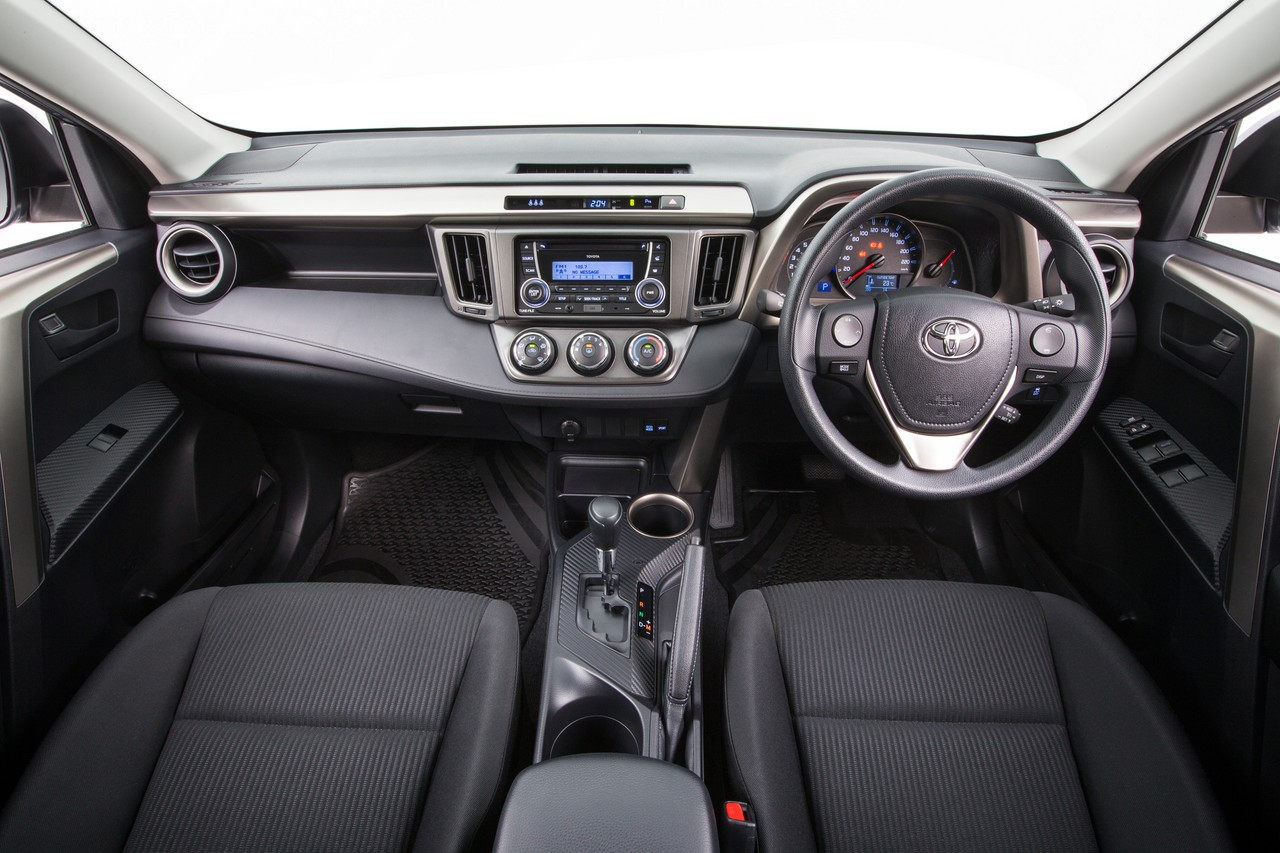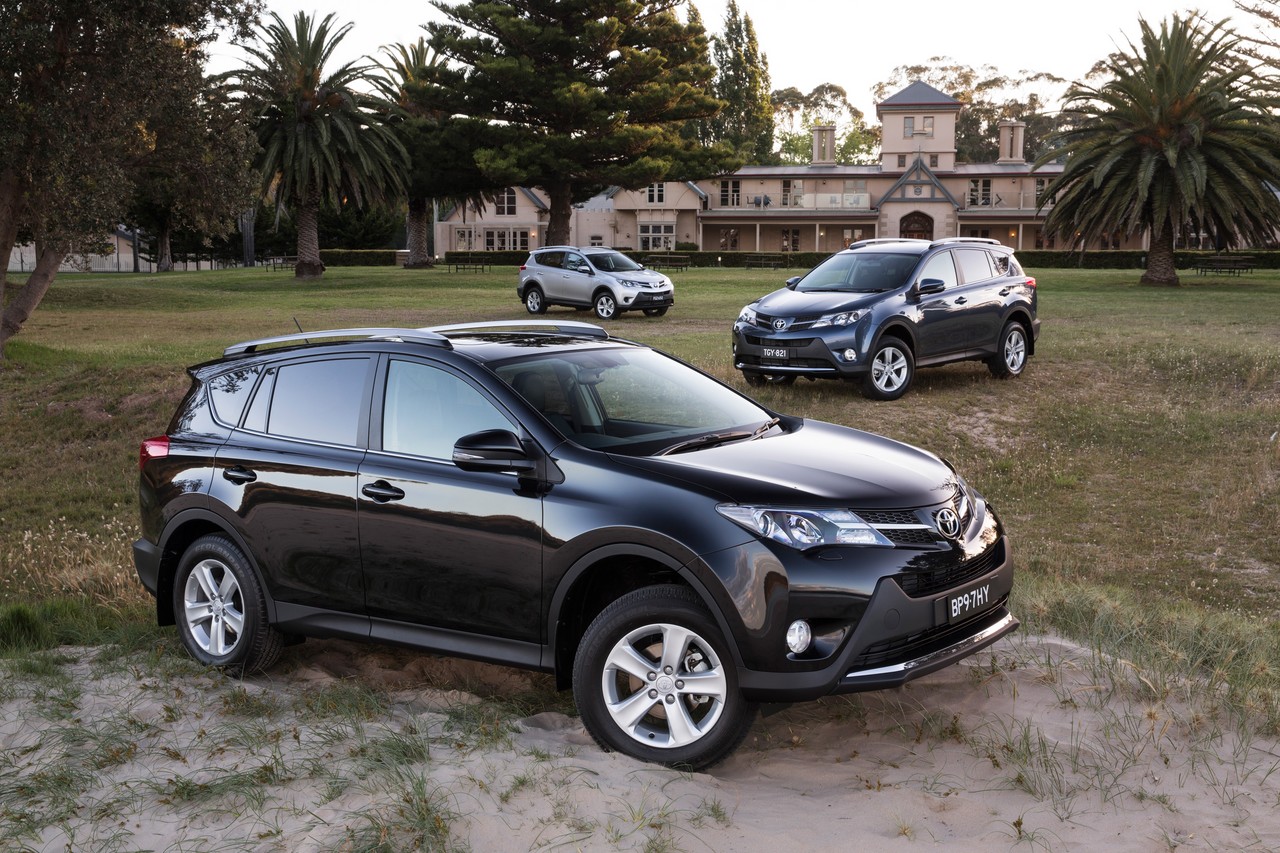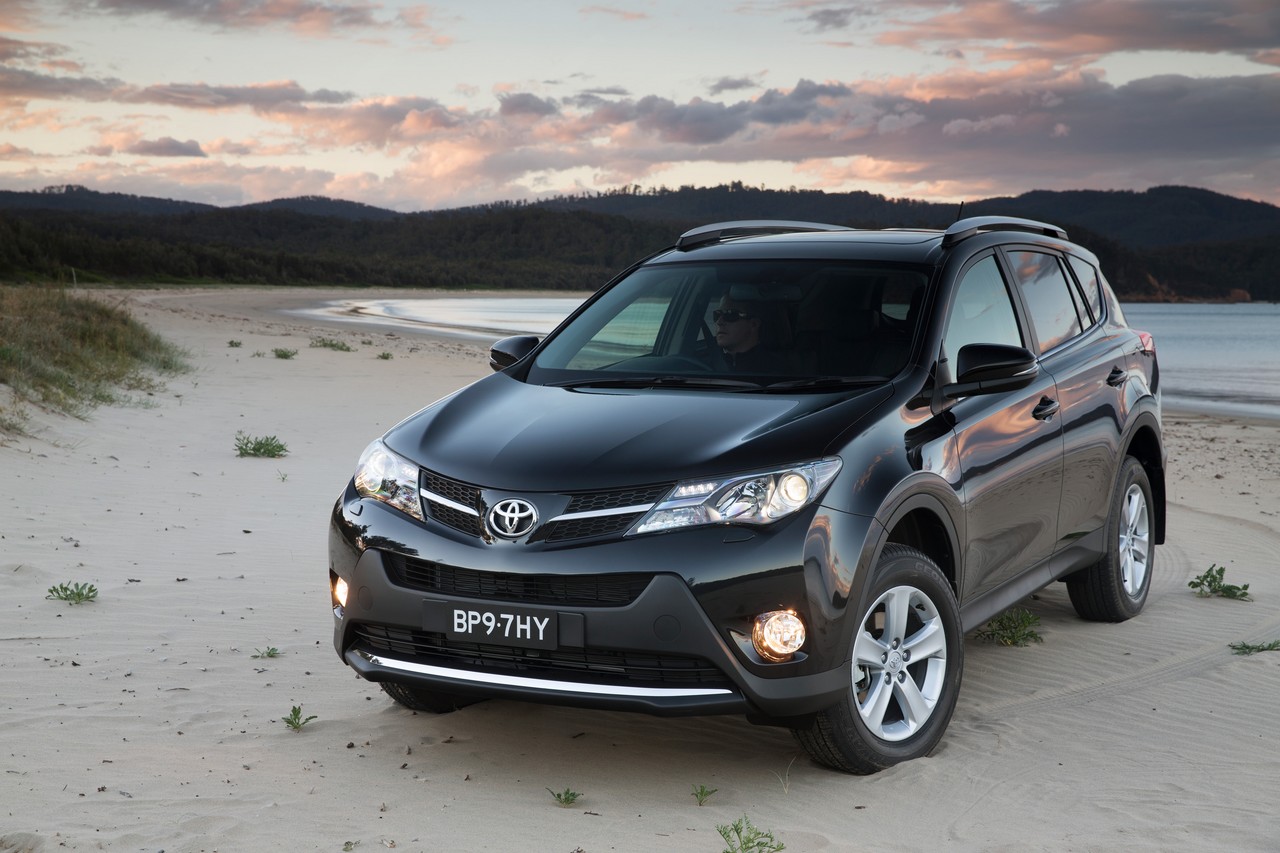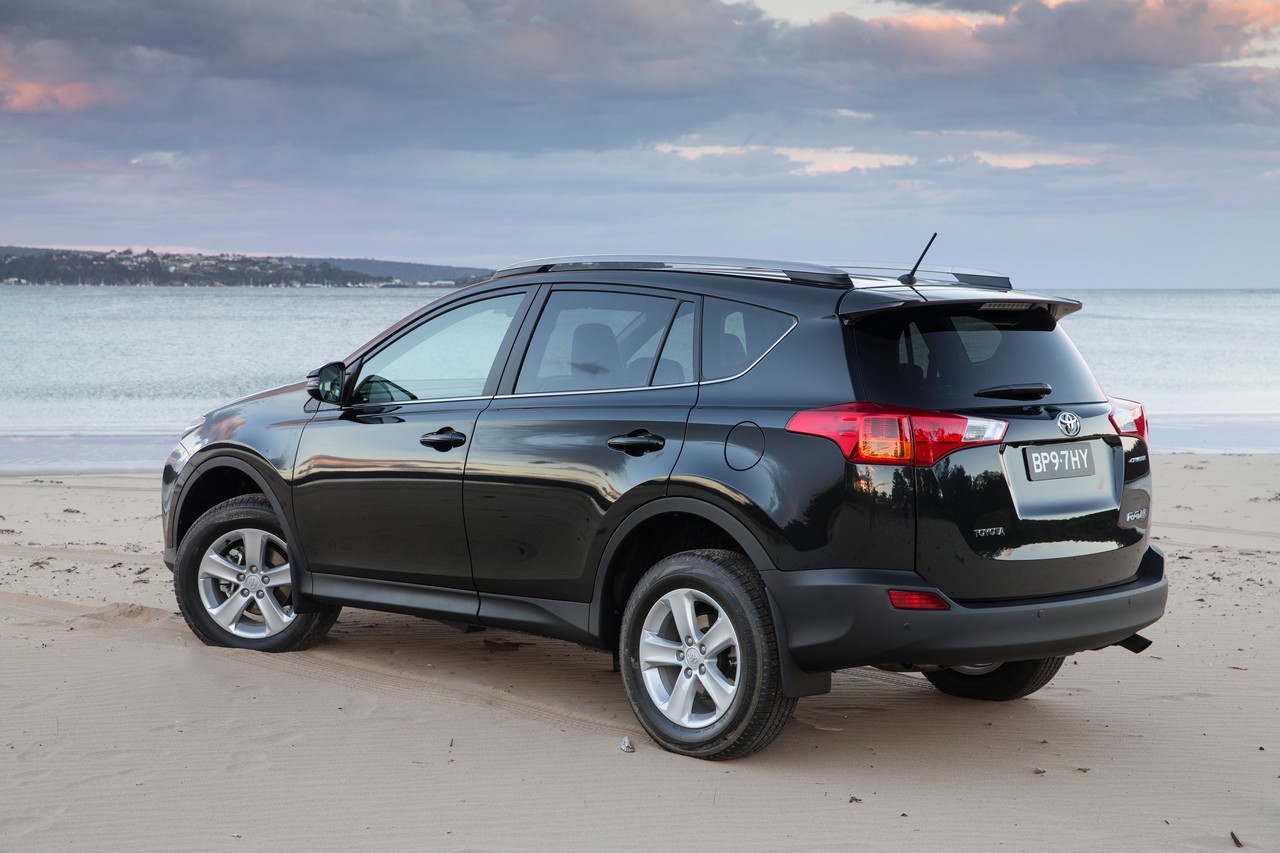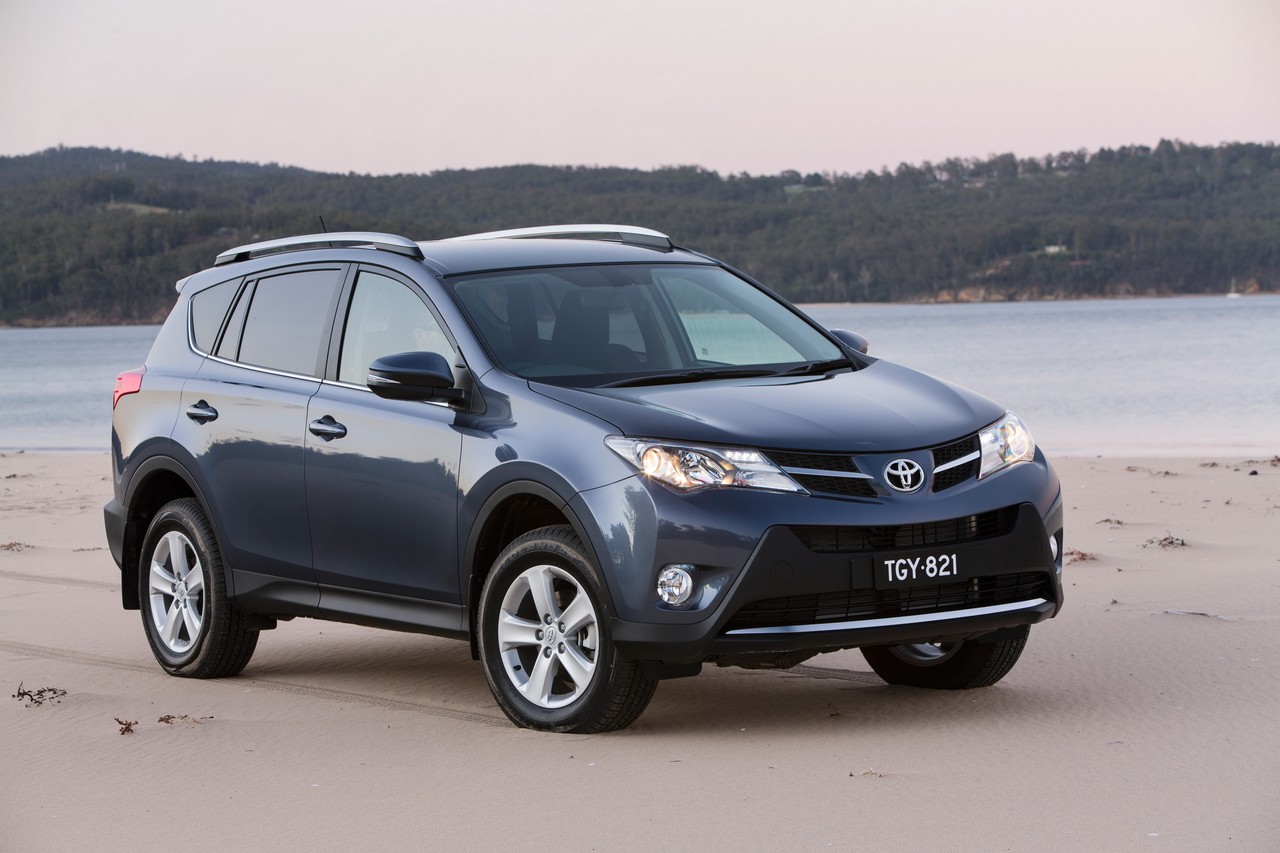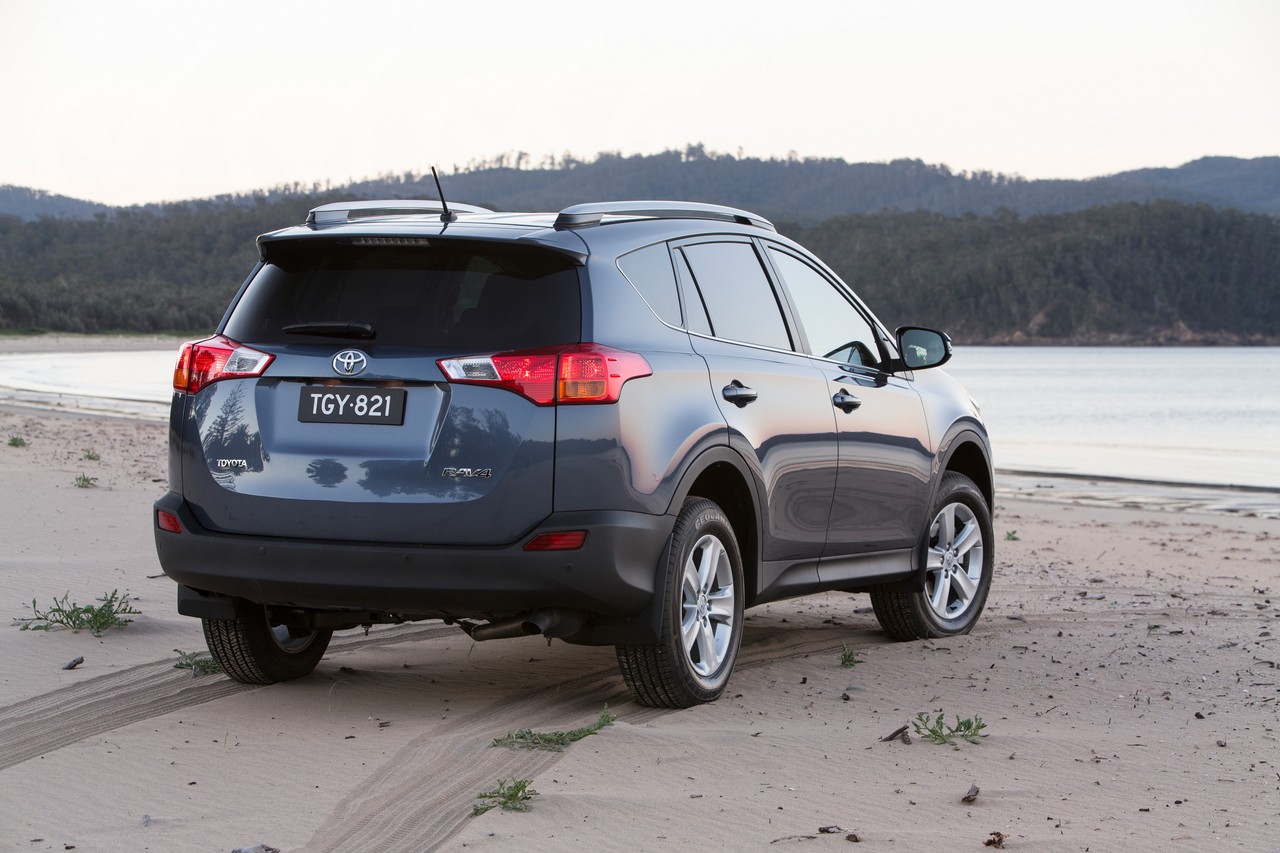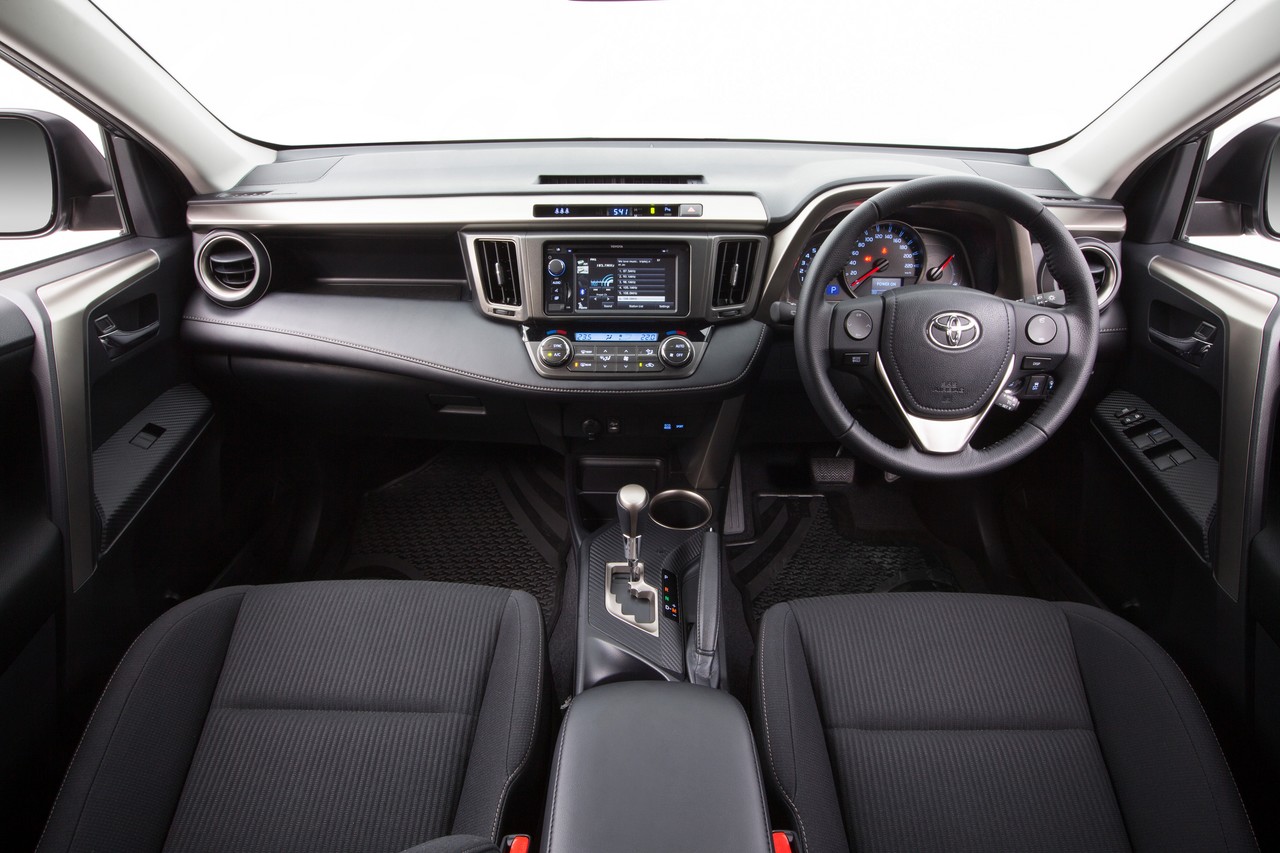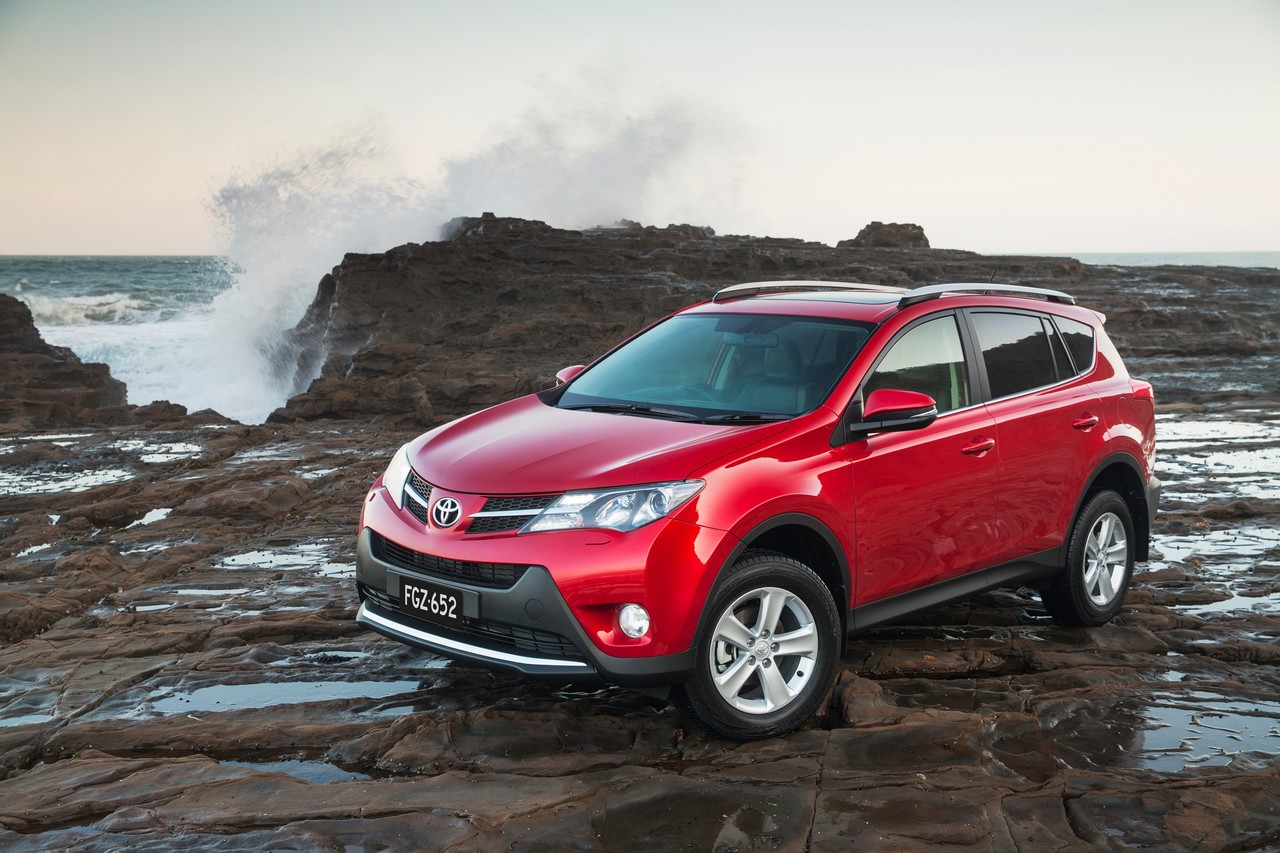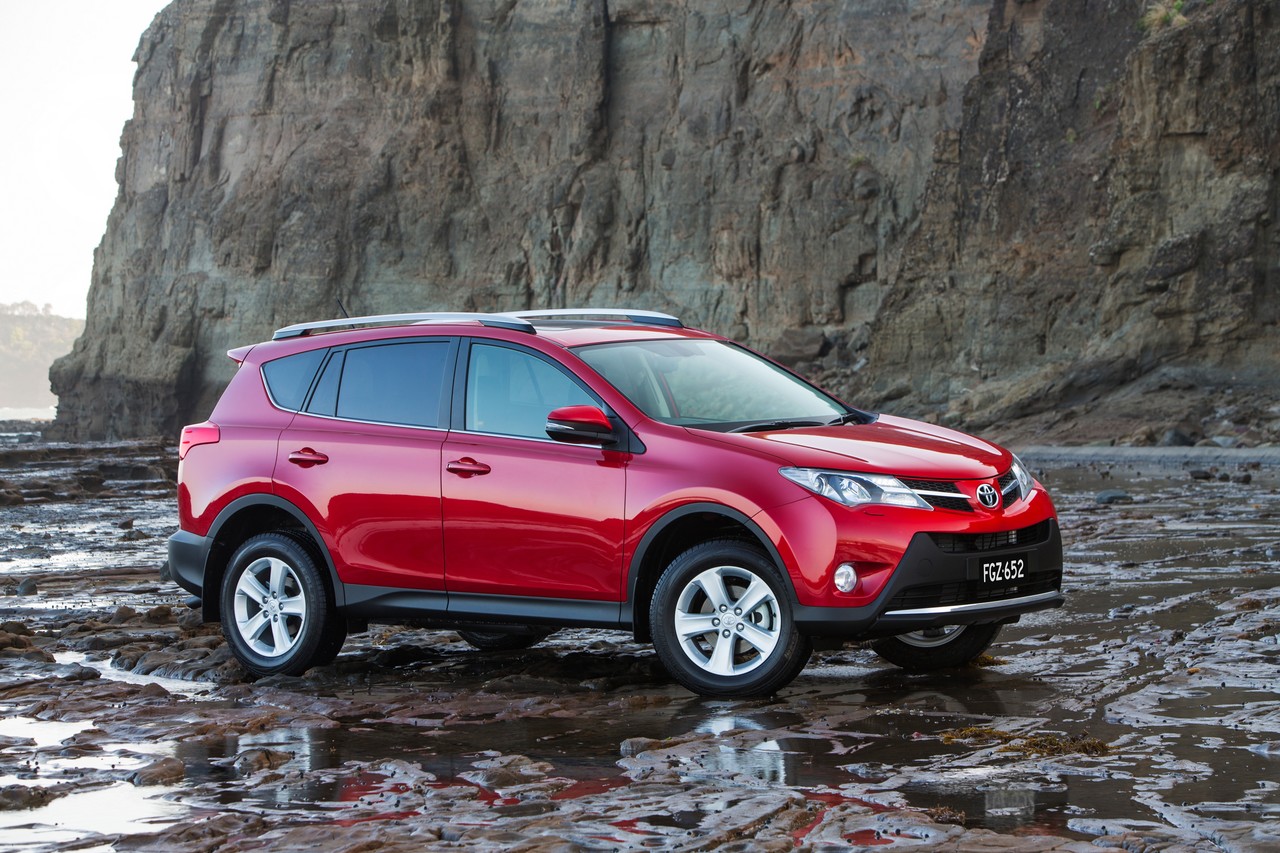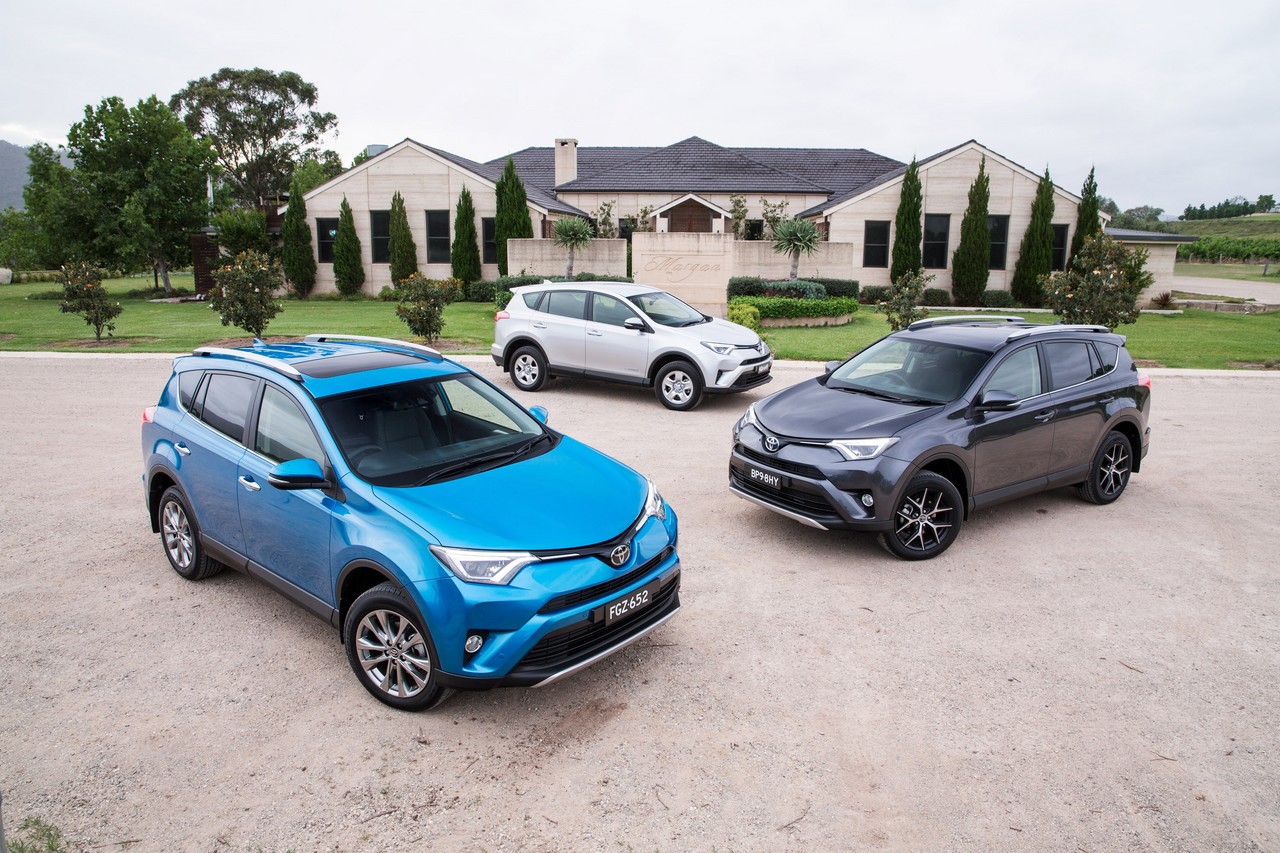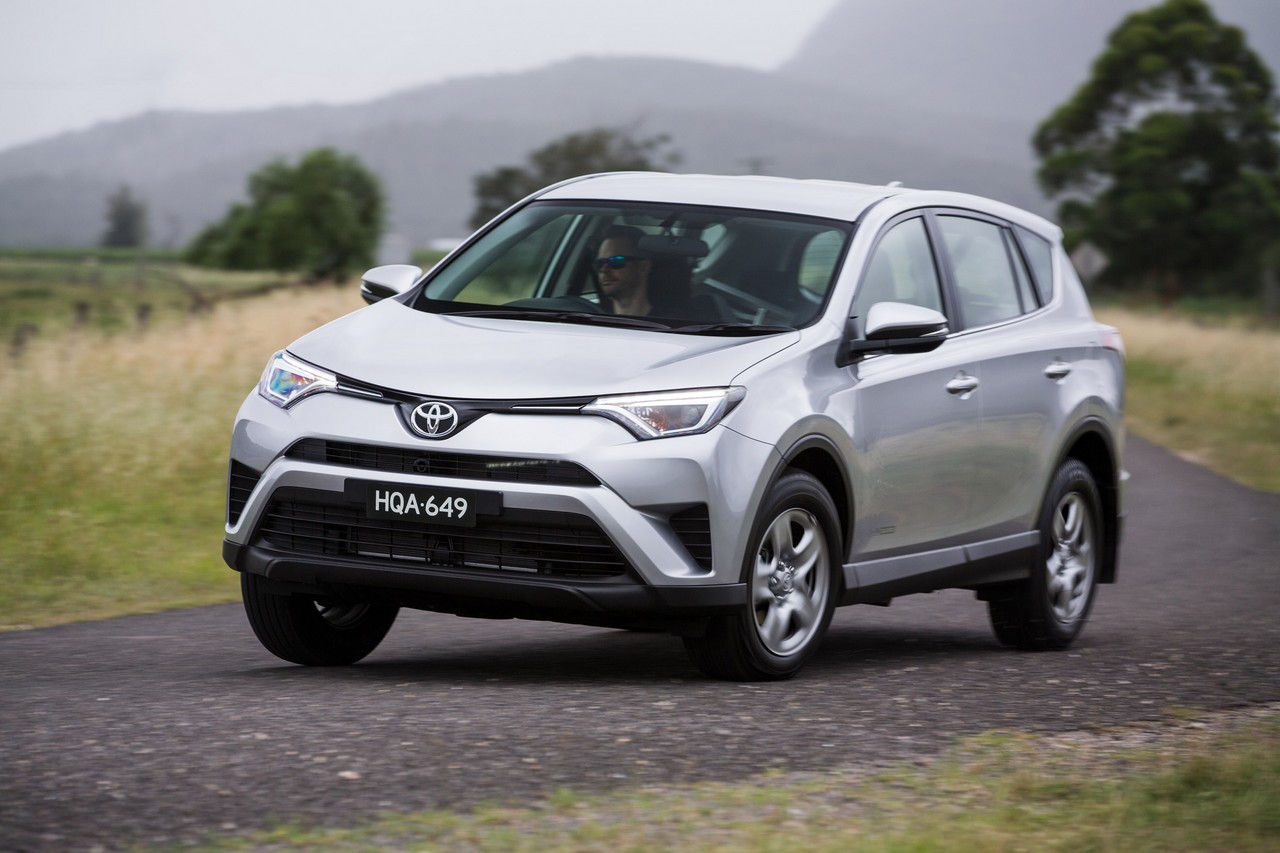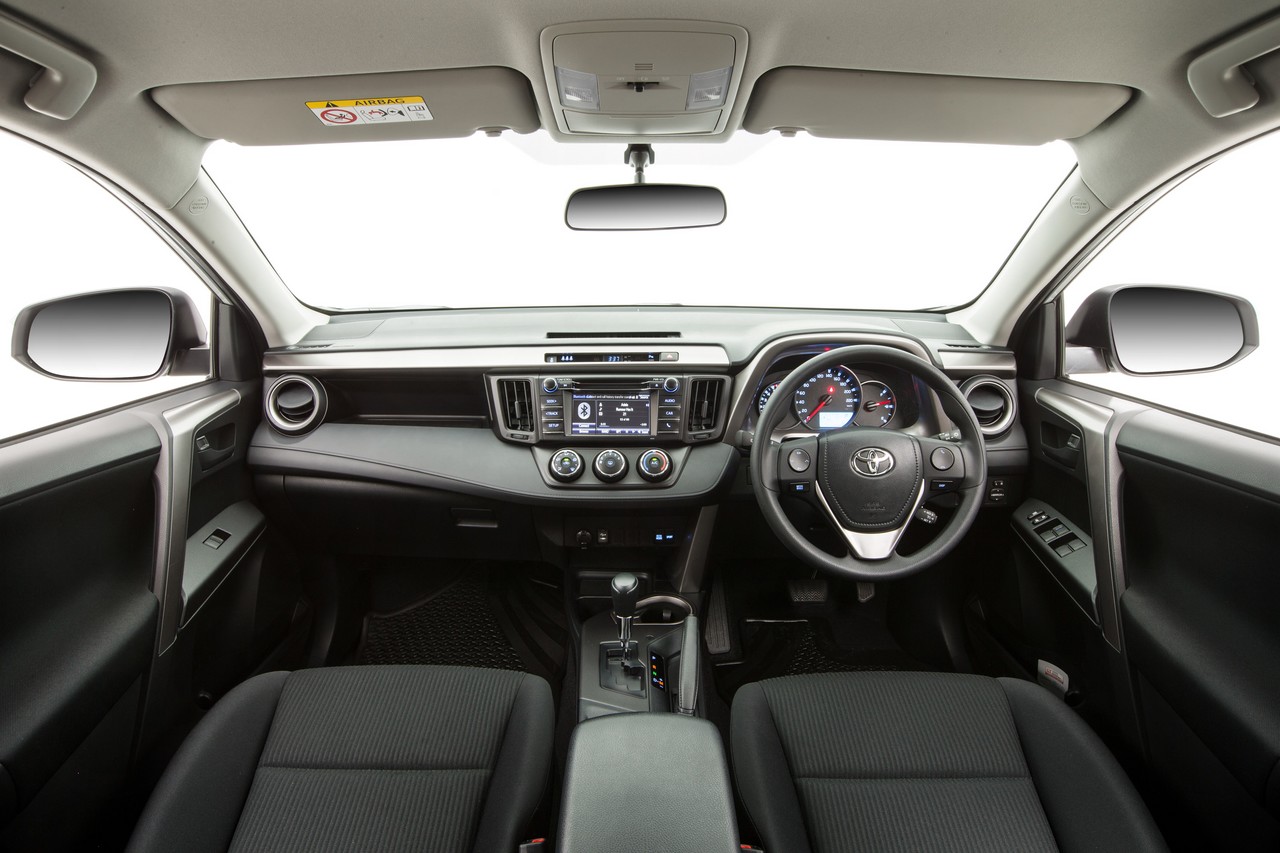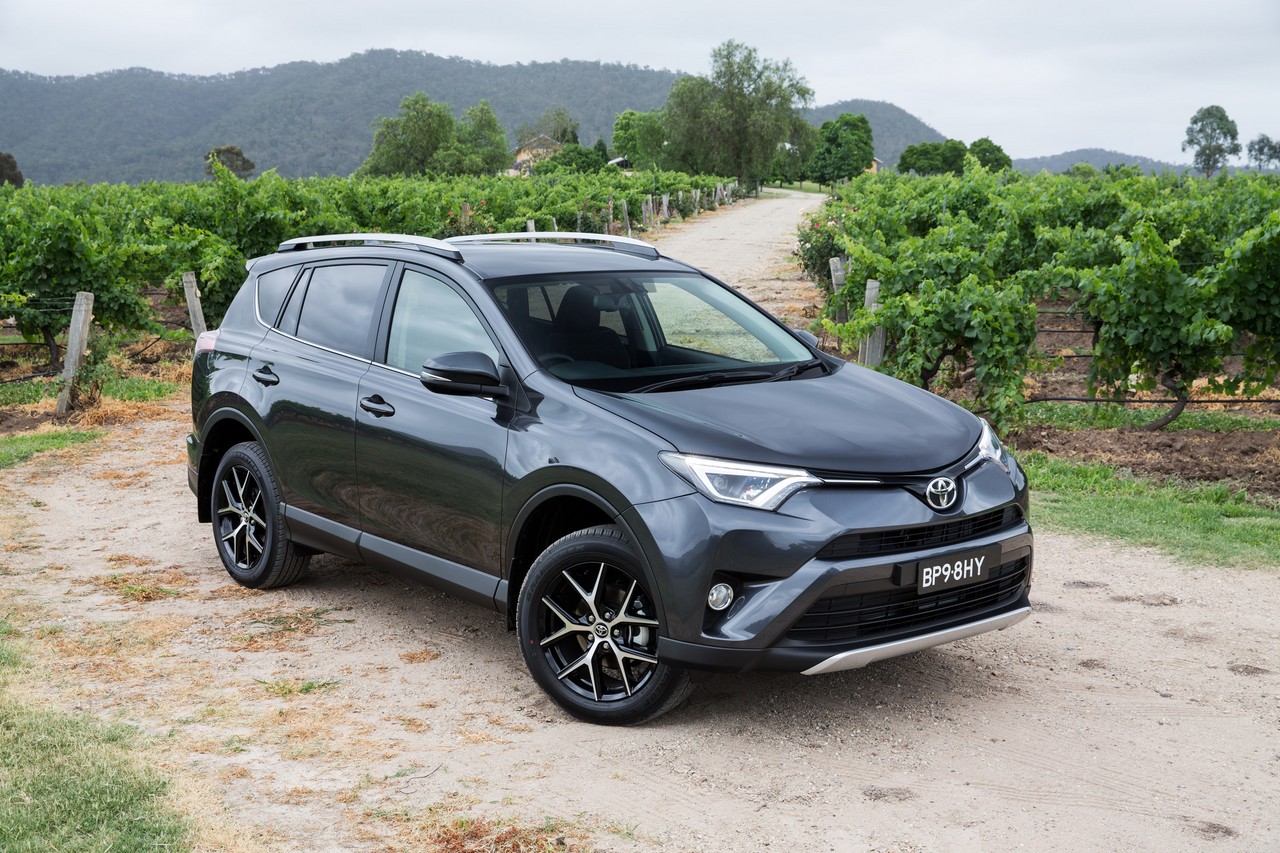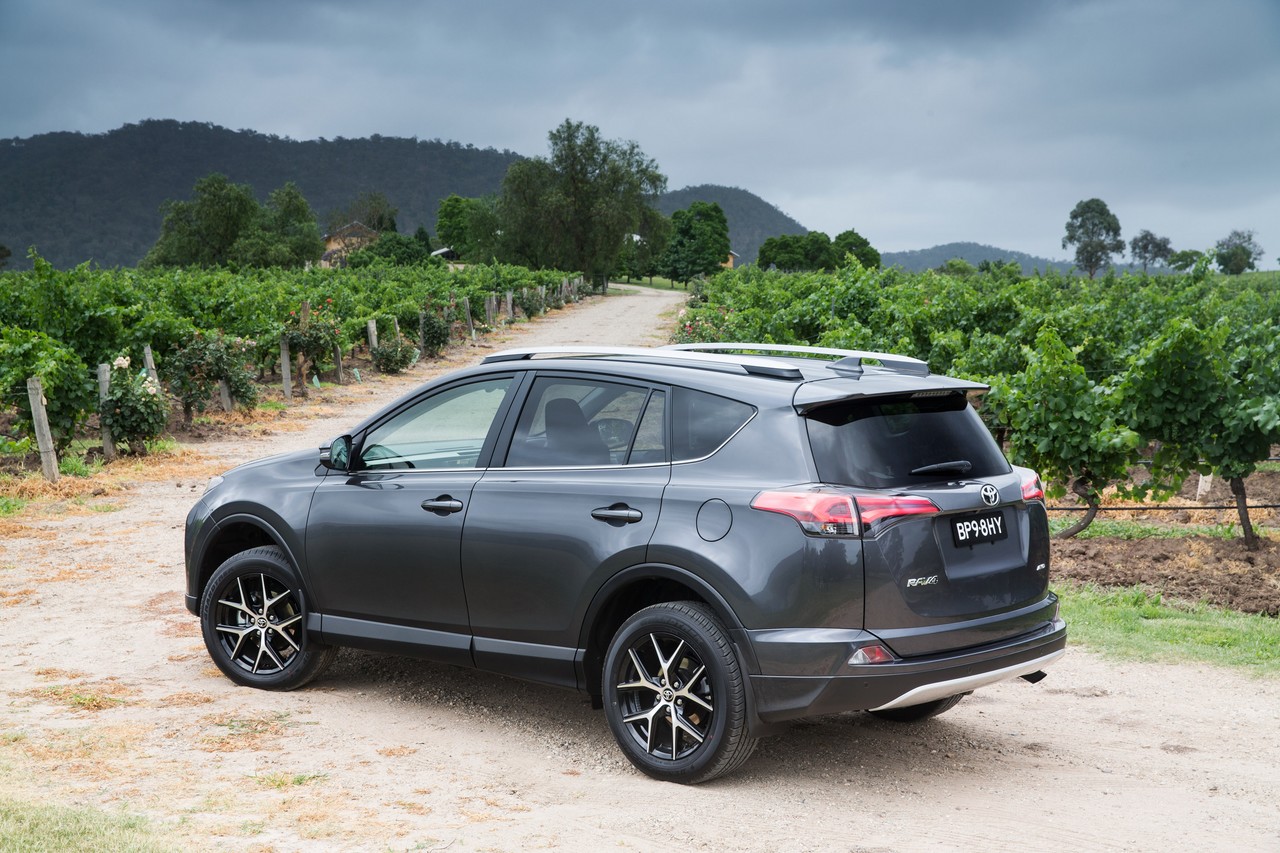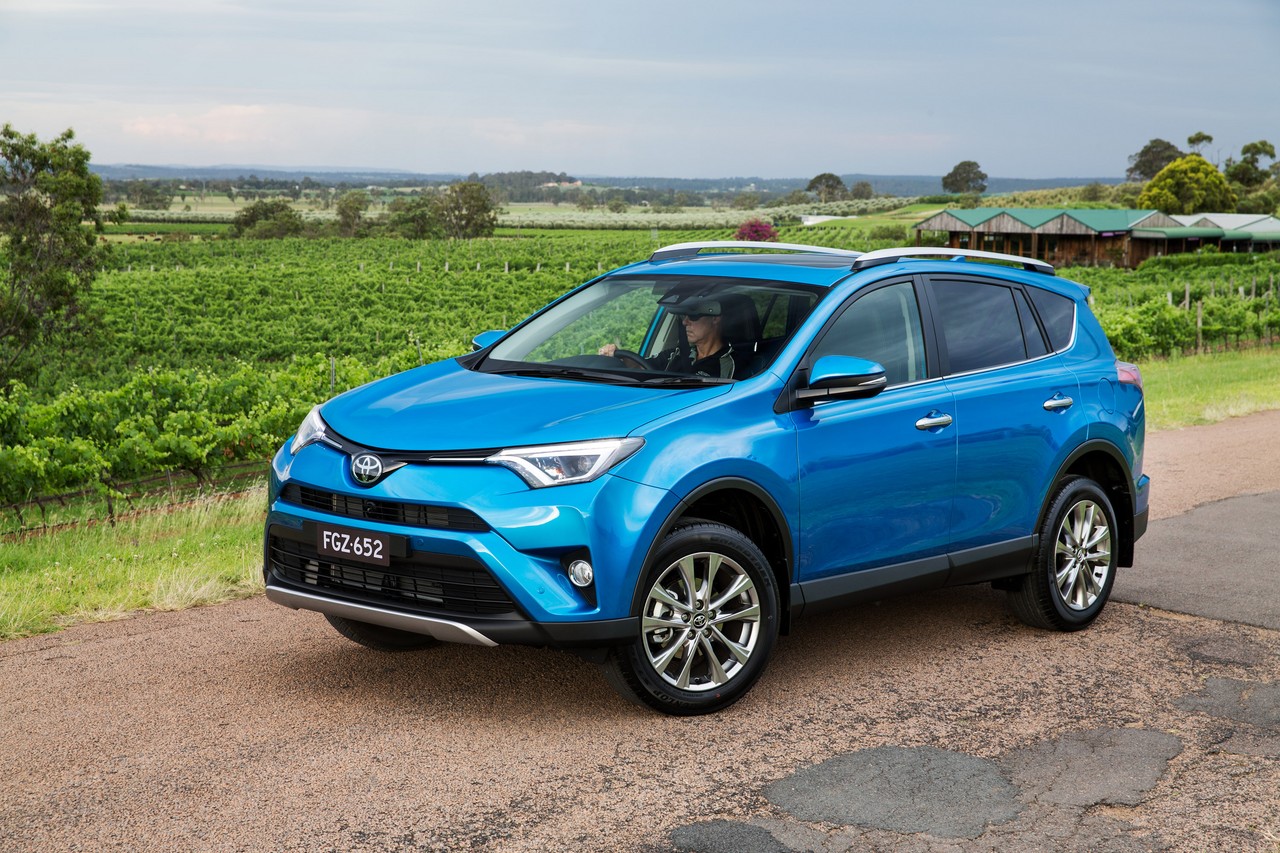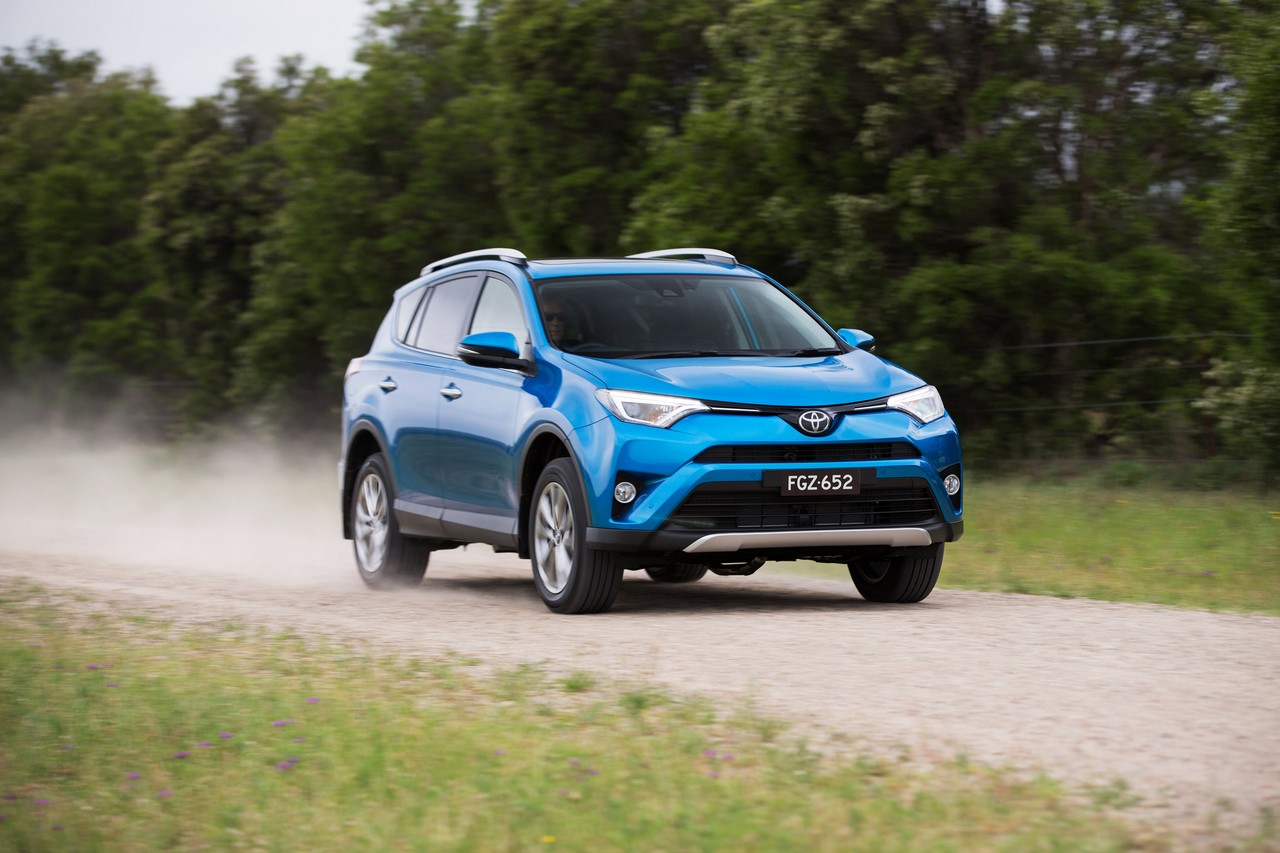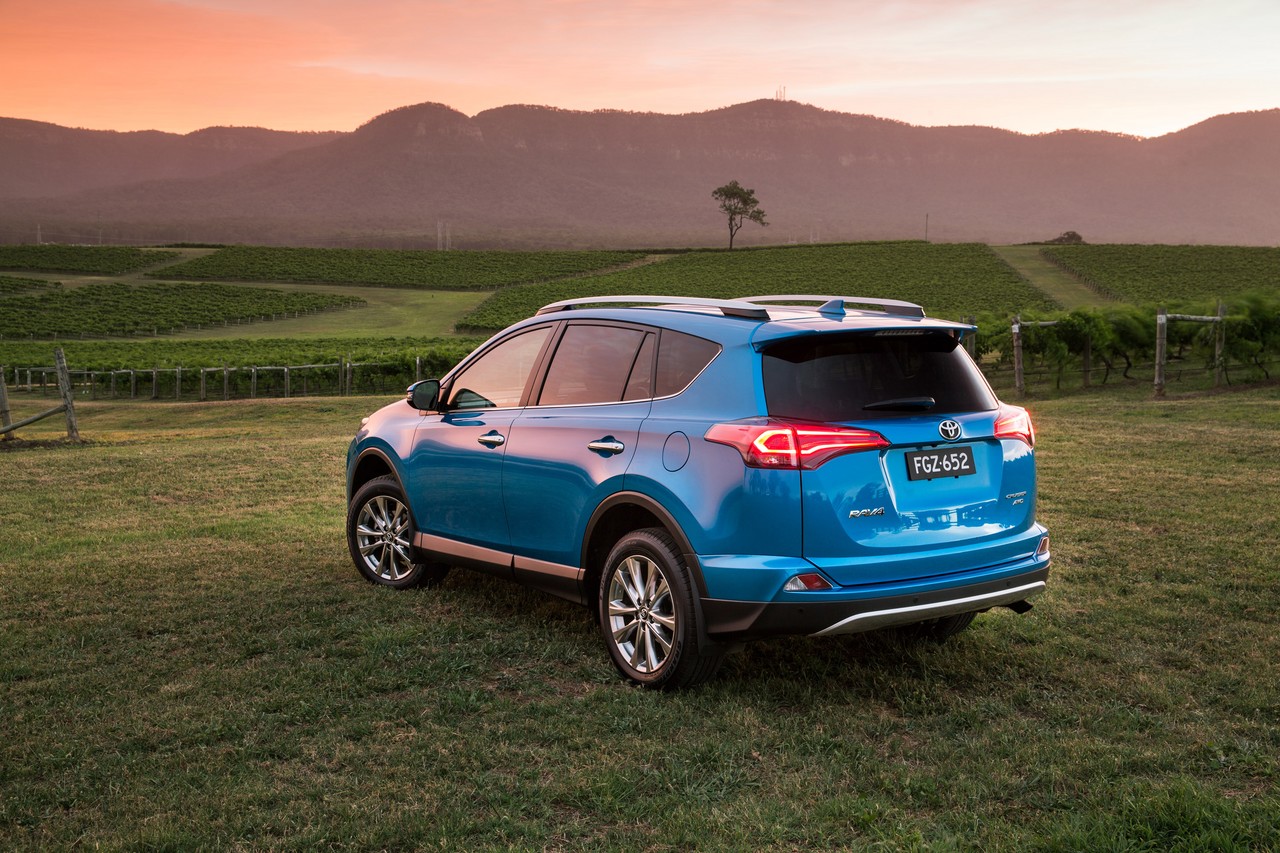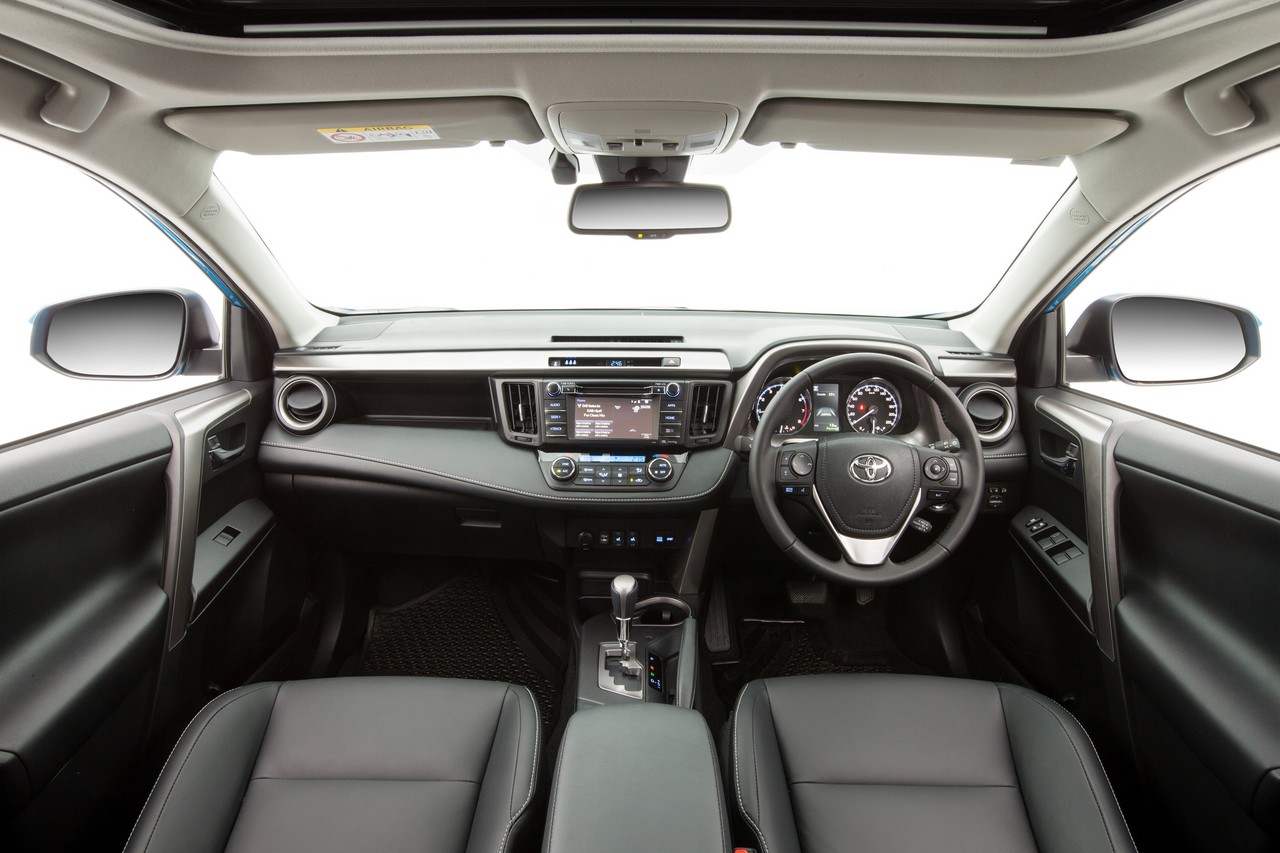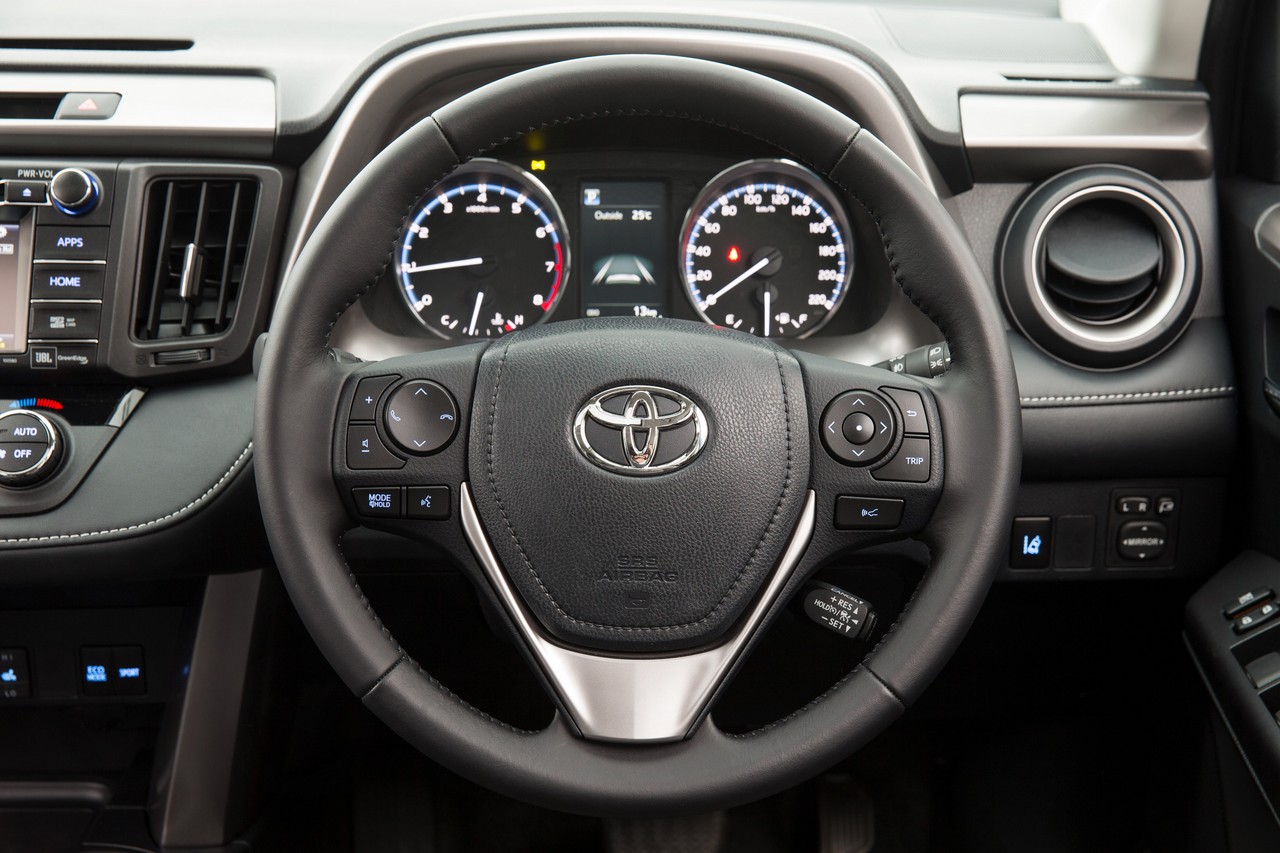
- Frugal and refined 2.2-litre 2AD-FTV turbo-diesel engine
- Spacious interior and supportive front seats
- Well-weighted steering provides good feedback
- Competent dynamics and generally comfortable ride…
- … but suspension lacks compliance over bumpy surfaces
- 2.0-litre 3RZ-FE petrol engine lacks low-rev torque
- Occasional and slight delay before AWD engages and, then, before ESC is activated
- Standard-fit Yokohama Geolander tyres lack wet-weather grip
- Diesel engines have low tow ratings
Review: Toyota XA40.I RAV4 (2013-15)
Overview
Released in February 2013, the Toyota XA40 RAV4 was a mid-size, five-seat SUV. Manufactured in Japan, the XA40 RAV4 was available in front- and all-wheel drive models, with a choice of petrol and turbo-diesel engines. Furthermore, the XA40 RAV4 range consisted of GX, GXL and Cruiser variants.
3ZR-FE, 2AR-FE and 2AD-FTV engines
Of the engines,
- the 2.0-litre 3ZR-FE petrol engine had double overhead camshafts, four valves per cylinder, dual variable valve timing with intelligence (‘VVT-i’) and a compression ratio of 10.0:1;
- the 2.5-litre 2AR-FE petrol engine had similar properties but was fitted with an acoustically-controlled induction system (operating from 2000-4000 rpm) and had a compression ratio of 10.4:1; and,
- the 2.2-litre 2AD-FTV turbo-diesel engine had common-rail direct injection, double overhead camshafts, four valves per cylinder and a compression ratio of 15.7:1.
As per the table below, these engines were available with manual, automatic and continuously variable transmissions (CVTs).
| Engine | Drive | Variant | Trans. | Years | Peak power | Peak torque |
|---|---|---|---|---|---|---|
| 2.0-litre petrol I4 (3RZ-FE) |
FWD | GX, GXL |
6sp man., 7sp CVT |
2013-15 | 107 kW at 6200 rpm | 187 Nm at 3600 rpm |
| 2.5-litre petrol I4 (2AR-FE) |
AWD | GX, GXL, Cruiser |
6sp man. | 2013 | 132 kW at 6000 rpm | 233 Nm at 4100 rpm |
| 6sp auto | 2013-15 | |||||
| 2.2-litre turbo-diesel I4 (2AD-FTV) |
AWD | GX, GXL |
6sp man. | 2013-15 | 110 kW at 3600 rpm | 340 Nm at 2000-2800 rpm |
| Cruiser | 6sp man. | 2013 | ||||
| 6sp auto | 2013-15 |
AWD system
The RAV4 had a ‘Dynamic Torque Control’ all-wheel drive system which utilised an electronically-controlled coupling. Furthermore, the all-wheel drive system had Auto, Lock and Sport modes:
- In Auto Mode, power was delivered primarily to the front wheels with all-wheel drive engaged only when needed to minimise fuel consumption;
- In Sport Mode, 10 per cent of the engine’s torque was directed to the rear wheels, increasing to 50 per cent under certain conditions. When cornering, for example, additional power was sent to the rear wheels – based on steering angle and yaw rate – to improve traction. Furthermore, torque could be directed to the rear wheels when understeer was anticipated, not just when wheel slip occured; and,
- At speeds below 40 km/h, Lock Mode provided a fixed 50:50 front:rear torque split for maximum traction. Beyond 40 km/h, however, Lock Mode automatically reverted to Auto Mode.
Dimensions and body
Compared to the XA30 RAV4 , the XA40 RAV4 was 55 mm shorter (at 4570 mm), 10 mm narrower (1845 mm) and 15 mm lower (1715 mm, including roof rails), though wheelbase length was unchanged (2660 mm). Furthermore, the XA40 RAV4 had a stiffer chassis due to the increased use of high-strength steel and additional spot welds around the front and rear door openings. Unlike its predecessors, the XA40 RAV4 had its spare tyre positioned under the cargo floor and the rear tailgate was hinged at the roof.
Suspension and steering
The XA40 RAV4 had MacPherson strut front suspension with wide-based L-shaped lower arms and trailing-type double wishbone rear suspension; the RAV4 was also fitted with an electric power steering system.
Safety equipment
Standard safety equipment for the Toyota RAV4 included dual front airbags, a driver’s knee airbag, front side airbags, full-length curtain airbags, ABS, electronic brake force distribution, brake assist, electronic stability control, traction control and front seatbelts with pretensioners and load limiters.
The RAV4 Cruiser was further equipped with Blind Spot Monitoring and, from November 2013, Reverse Cross Traffic Alert and Lane Departure Alert systems. Specifically,
- Reverse Cross Traffic Alert (RCTA) used rear radar sensors to detect approaching traffic that may cross the vehicle’s path as it was reversing. If detected, the driver would be warned via an audible tone; and,
- Lane Departure Alert could detect lane markings and would warn the driver via an audible tone if the vehicle was about to cross those markings without the driver having activated the indicators.
Brakes
The Toyota XA40 RAV4 had 296 mm by 28 mm ventilated front brake discs with floating callipers and 281 mm by 12 mm solid rear discs.
Euro NCAP testing
In Euro NCAP testing , the Toyota RAV4 – fitted with a 2.2-litre turbo-diesel engine – received a five star safety rating which included an 89 per cent adult occupant protection rating and an 82 per cent child occupant protection rating. In the offset crash test, there was a slight risk of serious injury for the driver’s head, chest and lower legs. Maximum points were awarded in the side impact test, though in the more severe pole test, there was a slight risk of serious injury for the driver’s chest.
Features: RAV4 GX, GXL and Cruiser
Standard features for the Toyota RAV4 GX included 17-inch steel wheels with Yokohama Geolander 225/65 R17H low-rolling resistance tyres, a six speaker sound system with a CD player, auxiliary inputs (3.5 mm/USB/iPod) and Bluetooth connectivity, air conditioning, cruise control, daytime LED running lights, rear parking sensors, 60/40 split and folding rear seats, remote central locking, power windows and heated mirrors, tilt and telescopic steering wheel adjustment, a tonneau cover, cargo net, roof rails, 12 volt power outlets and an immobiliser. AWD models were also fitted with an ‘acoustic’ windscreen which provided greater sound insulation.
Beyond this, the RAV4 GXL added 17-inch alloy wheels, dual-zone climate control air conditioning, contoured sports seats, front fog lights, a reversing camera, rain-sensing wipers, keyless entry, push-button start, power folding mirrors, rear privacy glass and a motion-sensing alarm.
Finally, the range-topping RAV4 Cruiser added a satellite navigation system, an eight-way power adjustable driver’s seat, leather seat trim, heated front seats, high-intensity discharge (HID) headlights, a power-operated luggage door, a tilt-and-slide moonroof and an electrochromatic rear view mirror.
November 2013: RAV4 update
In November 2013, standard RAV4 features were extended to include a 6.1-inch full-colour touch screen display and a reversing camera.
The RAV4 Cruiser was differentiated with 18-inch machined alloy wheels with 235/55 R18 Dunlop tyres, an 11 speaker JBL sound system with digital radio (DAB+), automatic high-beam headlights and ‘back guide monitoring’ for its reversing camera.
Brochure
Related links
- Specifiations: Toyota XA40 RAV4 (February 2013)
- Press Kit: Toyota XA40 RAV4 (February 2013)
- Press Release: Toyota XA40 RAV4 update (January 2014)
- Behind the Wheel: 2015 Toyota RAV4 Cruiser Review
Review: Toyota XA40.II RAV4 (2015-19)
Overview
Released in Australia in December 2015, the Toyota XA40 Series II (XA40.II) RAV4 introduced Euro V emissions compliant engines, updated styling and, for the RAV4 Cruiser, enhanced safety equipment. The XA40.II RAV4 could be identified by its bolder front mask which featured a larger lower grille and slimline LED projector headlights that incorporated high and low beams in a housing that also integrated LED daytime running lights. Revised front and rear bumpers increased overall length by 35 mm, while other changes included new wheel-arch mouldings, rocker panels, LED tail-lights and a shark fin antenna. Furthermore, the RAV4 GXL was fitted with 18-inch black alloy wheels with bright machined spokes (previously 17-inch wheels), while the 18-inch alloy wheels for the RAV4 Cruiser had a five twin-spoke design.
Inside, the Toyota XA40.II RAV4 had new matte black trim with contrasting silver accents and a redesigned centre console cup holder (so that it could hold mugs with handles). For the RAV4 GXL and Cruiser, a new two-dial instrument cluster with a 4.2-inch colour TFT multi-information display was introduced. For all models, however, thicker and extended sound insulation material reduced in-cabin noise.
The Toyota XA40.II RAV4 had a more rigid rear bodyshell for greater stability and ride quality. For the suspension, the shock absorbers and coil springs were revised to provide ‘a flatter, more comfortable ride and to enhance straight-line stability.’
| Engine | Drive | Trans. | Peak power | Peak torque |
|---|---|---|---|---|
| 2.0-litre petrol I4 (3RZ-FE) |
FWD | 6sp man., 7sp CVT |
107 kW at 6200 rpm | 187 Nm at 3600 rpm |
| 2.5-litre petrol I4 (2AR-FE) |
AWD | 6sp auto | 132 kW at 6000 rpm | 233 Nm at 4100 rpm |
| 2.2-litre turbo-diesel I4 (2AD-FTV) | AWD | 6sp man., 6sp auto |
110 kW at 3600 rpm | 340 Nm at 2000-2800 rpm |
Safety equipment
For the Toyota XA40.II RAV4 Cruiser, a forward-facing camera and millimetre-wave radar were introduced which provided the basis for the following safety technologies:
- Pre-Collision System with forward collision warning and emergency brake: monitored the distance to obstacles in front of the RAV4 and provided a warning if there was a risk of collision. If the driver did not respond, the brakes could be applied autonomously (i.e. autonomous emergency braking, or AEB) to reduce vehicle speed by up to 30 km/h; and,
- Toyota’s ‘Dynamic Radar Cruise’ Control (also known as Active Cruise Control): could maintain a specified distance from the vehicle ahead by controlling acceleration and braking.
As per the November 2013 update, the RAV4 Cruiser continued to be fitted with:
- Automatic High Beam (AHB): detected the headlights of oncoming vehicles and tail-lights of vehicles ahead, enabling the RAV4 to switch between high- and low-beam to avoid dazzling other drivers;
- Lane Departure Alert (LDA): could detect lane markings and would warn the driver via an audible tone if the vehicle was about to cross those markings without the driver having activated the indicators; and,
- Rear Cross Traffic Alert (RCTA): used rear radar sensors to detect approaching traffic that may cross the vehicle’s path as it was reversing. If detected, the driver would be warned via an audible tone.
The above safety technologies – and a Blind Spot Monitor (BSM) as fitted to the RAV4 Cruiser from launch – were available in an extra-cost, optional ‘technical pack’ for the RAV4 GXL with CVT or automatic transmissions.
In September 2017, standard safety equipment for the Toyota RAV4 GX and GXL was extended to include the Pre-Collision Safety System, Dynamic Radar Cruise Control, Automatic High Beam, Lane Departure Alert and Rear Cross Traffic Alert.
Features
Compared to the Toyota XA40.I RAV4, standard features were extended to include a 12 volt accessory socket for second row occupants.
The RAV4 GXL gained 18-inch black alloy wheels (previously 17-inch wheels) and an electrochromatic rear view mirror.
The range-topping RAV4 Cruiser gained front parking sensors, while its leather-accented seats could be specified in black, tan or beige depending on exterior colour.
September 2017 update
In September 2017, standard features for the Toyota RAV4 GX and GXL were extended to include a digital radio tuner, satellite navigation, fog lamps (already standard for GXL), dusk-sensing headlights and a 4.2-inch multi-information display in the instrument cluster.
Brochures
Related links
- Toyota Australia: Updated RAV4 Completes Toyota’s 2015 Renewal
- Toyota Australia: Toyota Expands RAV4 Safety, Features and Value (October 2017)
- Toyota Australia: Toyota RAV4
- Wikipedia.org: Toyota XA40 RAV4
